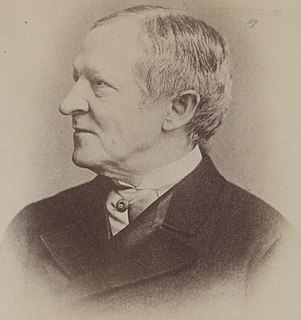
Levi Parsons Morton was the 22nd vice president of the United States from 1889 to 1893. He also served as United States ambassador to France, as a U.S. representative from New York, and as the 31st governor of New York.

Grinnell is a city in Poweshiek County, Iowa, United States. The population was 9,564 at the time of the 2020 census. It is best known for being the home of Grinnell College.

Medina is a village in the Towns of Shelby and Ridgeway in Orleans County, New York, United States. It is located approximately 10 miles south of Lake Ontario. The population was 6,065 at the 2010 census, making it the county's most populous municipality. The village was named by its surveyor, Ebenezer Mix. It is part of the Rochester Metropolitan Statistical Area. The Medina zip code, 14103, encompasses the village of Medina and the surrounding towns of Ridgeway and Shelby. The United States Census Bureau estimates the 2017 population of this area to be 17,234.
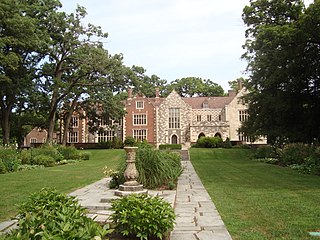
Salisbury House in Des Moines, Iowa is a Tudor, Gothic and Carolean style manor home. It was built by cosmetic magnate Carl Weeks and his wife, Edith Van Slyke Weeks, between 1923 and 1928. Salisbury House was modeled after the King's House in Salisbury, England, contains 42 rooms and measures just over 22,000 square feet (2,000 m2). The property is owned and operated by the Salisbury House Foundation and is open to the public for tours, public events, and private rentals.

The Merchants' National Bank (1914) building is a historic commercial building located in Grinnell, Iowa. It is one of a series of small banks designed by Louis Sullivan in the Midwest between 1909 and 1919. All of the banks are built of brick and for this structure he employed various shades of brick, ranging in color from blue-black to golden brown, giving it an overall reddish brown appearance. It was declared a National Historic Landmark in 1976 for its architecture. In 1991 it was listed as a contributing property in the Grinnell Historic Commercial District.

The Coffin House is a National Historic Landmark located in the present-day town of Fountain City in Wayne County, Indiana. The two-story, eight room, brick home was constructed circa 1838–39 in the Federal style. The Coffin home became known as the "Grand Central Station" of the Underground Railroad because of its location where three of the escape routes to the North converged and the number of fleeing slaves who passed through it.
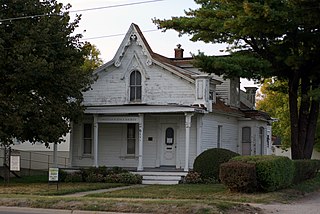
Charles H. Spencer House, formerly Christian Science Society and First Church of Christ, Scientist, Grinnell, located in Grinnell, Iowa, in the United States, is an historic Carpenter Gothic house which was converted into a church. On January 25, 1980, it was added to the National Register of Historic Places.
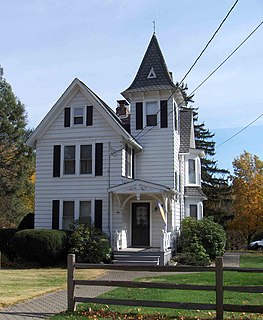
Marion is a neighborhood in the town of Southington in Hartford County, Connecticut, United States. It is generally the area in the vicinity of the intersection of Route 322 and Marion Avenue just north of the Cheshire town line.
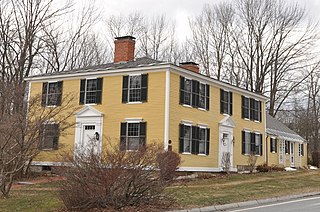
The Levi Woodbury Homestead is a historic house at 1 Main Street in Francestown, New Hampshire. With a construction history dating to 1787, it is a good local example of Federal period architecture. The house is most significant as the only known surviving structure that has a significant association with statesman Levi Woodbury (1789–1851), who had a long career as a successful politician and jurist. The house was listed on the National Register of Historic Places in 2007.

Stephen Carpenter Earle was an architect who designed a number of buildings in Massachusetts and Connecticut that were built in the late 19th century, with many in Worcester, Massachusetts. He trained in the office of Calvert Vaux in New York City. He worked for a time in partnership with James E. Fuller, under the firm "Earle & Fuller". In 1891, he formed a partnership with Vermont architect Clellan W. Fisher under the name "Earle & Fisher".

Alfredo S. G. Taylor (1872–1947) was an architect, of the New York firm Taylor & Levi, which he co-founded with Julian Clarence Levi.

The Levi Hexter House is a historic house located in southwest Portland, Oregon, United States that is listed on the National Register of Historic Places. It is located within the King's Hill Historic District.
Frank E. Wetherell was an American architect in the U.S. state of Iowa who was active from 1892 to 1931. He founded the second oldest architectural firm in the state in Des Moines, Iowa, in 1905. He worked with Roland Harrison in partnership Wetherell & Harrison. The firm designed numerous Masonic buildings.

The E.A. and Rebecca (Johnson) Marsh House is a historic dwelling located in Grinnell, Iowa, United States. Marsh was a jeweler and a leading businessman in the city. His wife, Rebecca Penrose Johnson, bought the property in 1891. Her father was a successful businessman who amassed his own fortune, which is probably why the property was bought in her name. The two-story frame structure features a hipped roof with cross gables and a corner tower. It is one 19 Queen Anne houses in Grinnell with a corner tower. Unlike most of the others, it has maintained a high degree of historic integrity. The house was listed on the National Register of Historic Places in 1999.

The North Grinnell Historic District is a nationally recognized historic district located in Grinnell, Iowa, United States. It was listed on the National Register of Historic Places in 2008. At the time of its nomination it contained 272 resources, which included 202 contributing buildings, six contributing objects, 61 non-contributing buildings, and one non-contributing object. The historic district is a residential area located west of the Grinnell College campus. Of the 157 houses, three-quarters of them are two-story structures. The rest are bungalows, cottages, and post-World War II minimal traditional plans. The vast majority of houses are of frame construction, with a few brick, concrete block, stucco and half-timbered claddings. There are 103 outbuildings, which include garages, barns and carriage houses. Three of the most prominent architectural styles include Neoclassical, Queen Anne and American Craftsman. The historical objects are six concrete hitching posts. Eleven architects are known to have houses in the district. The period of significance is 1867 to 1958.

The Grinnell Herald Building is a historic structure located in Grinnell, Iowa, United States. The Herald was established in 1869 with the Rev. J. M. Hillyer as the first editor. Lowrie Frisbie began his 50-year tenure as its editor in the early 20th-century. In its early years the newspaper was housed in numerous buildings in the city's central business district. Its owners put up this Neoclassical brick building in 1916. It was designed by the prominent Des Moines architectural firm of Proudfoot, Bird & Rawson. The same year the Herald's competitor, the Grinnell Register, erected their own building. The two newspapers merged in 1936 to form the Grinnell Herald-Register. They choose this building to house their operations, and it continues to do so. It was listed on the National Register of Historic Places in 1991.

The Interior Telephone Company Building is a historic structure located in Grinnell, Iowa, United States. Iowa was one of the leading Midwest states to adopt the telephone as a means of communication. By 1920 86% of the state's farms had a telephone. The Interior Telephone Company was established to serve the Grinnell area. It was one of two companies to provide the service locally, and one of 500 independent telephone companies that provided local service and connected to the Bell System for long distance. Interior Telephone built this building to house its operations in 1912. It is a one-story brick structure built over a raised basement. The telephone equipment was housed in the basement, and office space was located on the main floor. The building was built to stand apart from the surrounding buildings, perhaps as a means for fire protection. The company's initials, I.T.C., are part of the brickwork on both side of the building. It was listed on the National Register of Historic Places in 1990.
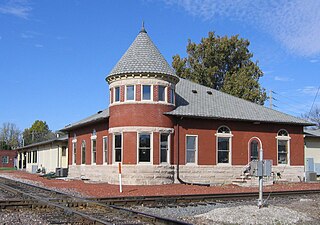
Union Depot, also known as the Grinnell Union Depot, is an historic building located in Grinnell, Iowa, United States. The Chicago, Rock Island & Pacific Railroad built the first tracks through the area in 1863, and they built a simple frame depot the same year. The Central Railroad of Iowa extended its north–south line to Grinnell nine years later, and their tracks crossed the Rock Island tracks at this location. The Minneapolis and St. Louis Railway eventually acquired the Central Railroad. The old depot became too small and this one replaced it in 1893. It was designed by the Rock Island Lines and built by a local contractor. The one-story, brick structure follows a square plan with a round corner tower at the junction of the two tracks. The tower provided the station agent with a clear view in all directions.
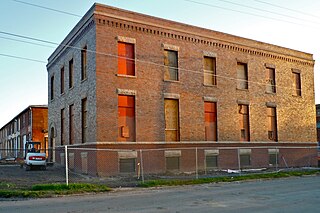
The Spaulding Manufacturing Company is a complex of historic buildings located in Grinnell, Iowa, United States. Vermont native H.W. Spaulding settled in Grinnell in 1876 to open a blacksmith and wagon repair shop. Not long after, he started to manufacture wagons. Because of his modest success he entered into a series of partnerships over the years. The oldest building in the complex was completed around 1880, and the company grew to a complex of five buildings. The last building was completed in 1910, and has a masonry chimney that originally rose to 110 feet (34 m) high. All the buildings are brick construction, and they range in height from two floors to three floors. As modes of transportation began to change, so did Spaulding. The company began manufacturing automobiles. They were one of several early automobile manufacturers that had existing operations that manufactured bicycles, wagons, and carriages. They went out of business in 1929. Since that time the facility has housed a variety of small-scale manufactures, and even a veterinary clinic. Part of the plant was renovated and now houses the administration offices for the City of Grinnell and displays for the Iowa Transportation Museum. The largest buildings of the manufacturing complex were renovated and converted into the Spaulding Lofts apartments. The complex was listed on the National Register of Historic Places in 1978.

Goodnow Hall is a historic structure located on the Grinnell College campus in Grinnell, Iowa, United States. A tornado struck the college's campus in 1882, and this was one of four buildings that replaced the destroyed buildings. It is now the oldest building on campus. The other three are no longer extant. The building is named for Edward A. Goodnow, who was a well-known abolitionist and reformer who promoted public education for women. He donated $10,000 to the college to construct this building, which was the library until 1905. It was converted into office space and classrooms after that time. It was renovated again in 1995, and it housed the Department of Anthropology and later the Department of Gender, Women's, and Sexuality Studies. The three-story building was designed by Worcester, Massachusetts architect Stephen C. Earle in the Richardsonian Romanesque style. It features a tower on the northwest corner of the structure that was originally capped by a domed astronomical observatory. The exterior is composed of rusticated Sioux Falls granite. The building was listed on the National Register of Historic Places in 1979.






















